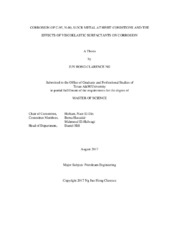| dc.description.abstract | In the oil and gas industry, corrosion damage during treatments often occurs due to the use of corrosive treatment fluids and can result in problems such as tubular or equipment failure, and leaking. These problems can incur high costs of maintenance and pose as safety hazards to workers on site.
Hydrochloric acid (HCl) is a cheap and cost effective fluid that is commonly used in the oil and gas industry to dissolve scale and acidize formations. However, at high temperatures, it becomes extremely corrosive. Alternative acidizing fluids are typically used in place of HCl at these temperatures. However, in the event that HCl is required, corrosion inhibitors are added to the solution.
In this work, the corrosion rates of two blends of HCl based acidizing fluids were tested on C-95, N-80, and S13Cr. The results show that the corrosion rate of the acidizing fluid is the lowest for N-80 metal under all conditions tested. An increase in corrosion rates for blend A tests as acid concentration increased was observed to be higher at 280°F than at 240°F despite a 1 vol% increase in corrosion inhibitor concentration to compensate for the increase in acid concentration. The increase in corrosion rates at 240°F ranged from 0% to 9% while the range increased to 17% to 36% at 280°F. Blend B showed significant reduction in protection for N-80 at 280°F when acid concentration was raised to 20 wt% with the change in corrosion rate increasing to 68.2% from 9.2% at 240°F. In addition, VES was shown to influence the corrosion rates of N-80 and S13Cr metal negatively. The absence of VES from blend B at 280°F showed a corrosion rate of 0.0216 lb/ft² and 0.0159 lb/ft² for S13Cr and N-80, respectively. These rates increased to 0.0253 lb/ft² and 0.0169 lb/ft² with 5% VES, and to 0.0264 lb/ft² and 0.0187 lb/ft² respectively when 8% VES was used. A green coloration of the post-corrosion solution was observed when blend A was used with S13Cr metal. | en |


